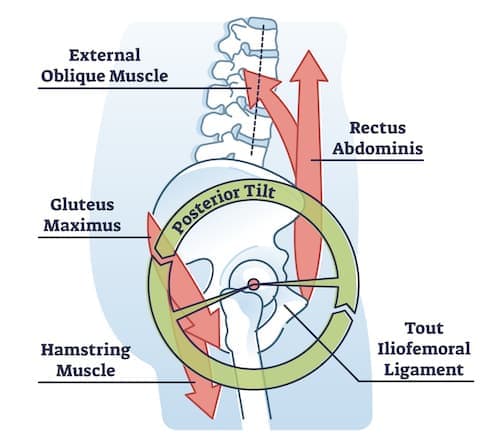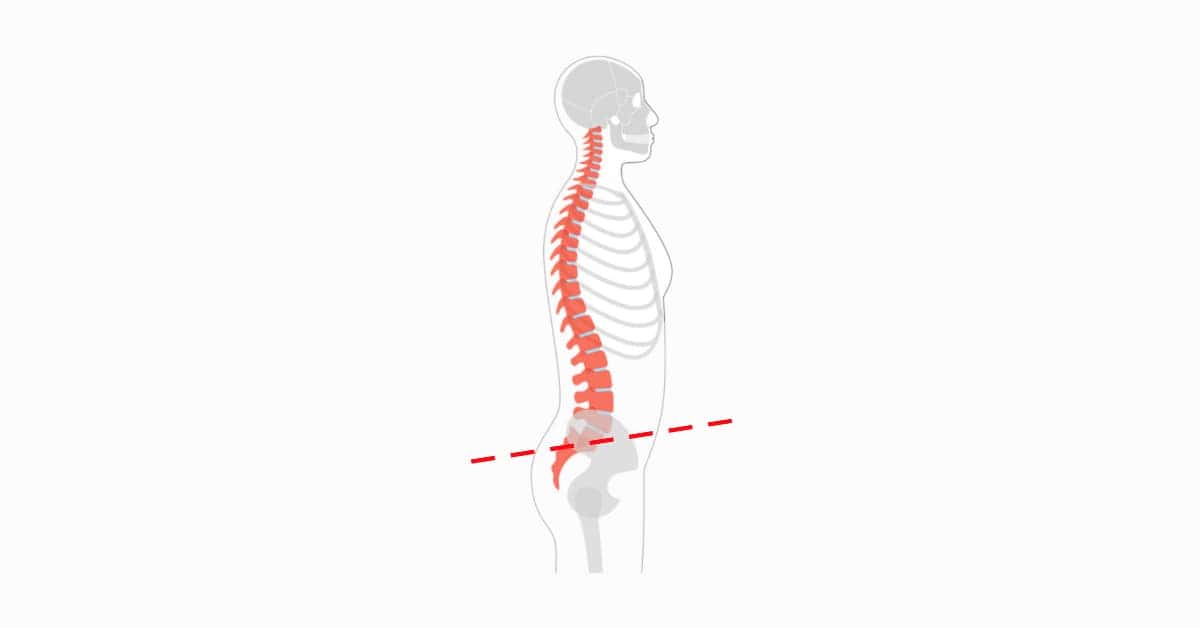If you spend most of your day sitting, whether it’s at a desk, in your car, or on the couch, you may be familiar with the discomfort that comes with a posterior pelvic tilt. This common postural issue occurs when the pelvis rotates backwards, causing the lower back to flatten and placing undue stress on the muscles and joints in the hips and lower back.
Fortunately, there are simple exercises and stretches that you can do at home to alleviate the discomfort associated with a posterior pelvic tilt. This article will walk you through some of the best techniques and exercises for fixing a posterior pelvic tilt.
I. Understanding Posterior Pelvic Tilt

A posterior pelvic tilt is a postural misalignment where the pelvis is tilted backwards, causing the lower back to appear flattened. This position of the pelvis reduces the natural curve of the lumbar spine, which may result in discomfort, pain, and reduced mobility.
A posterior pelvic tilt often occurs due to muscle imbalances, with tight abdominal and hamstring muscles pulling the pelvis into this tilted position. In contrast, weak glutes, core muscles, hip flexors and quads may fail to counteract this pull and maintain proper pelvic alignment.
A. Causes of Posterior Pelvic Tilt
Earlier, we touched on how muscle imbalances contribute to posterior pelvic tilt. However, it’s important to understand the factors that lead to these muscle imbalances in the first place. Let’s explore some common causes that contribute to the development of posterior pelvic tilt.
- Poor Sitting Posture: One of the main culprits behind posterior pelvic tilt is poor sitting posture, particularly sitting in a posteriorly tilted pelvic position. This may look like slouching with the back in a shallow “C” curve instead of sitting upright. Sitting for extended periods in this position can contribute to muscle imbalances and posterior pelvic tilt development.
- Standing with Poor Posture: Similarly, standing with poor posture in a posterior pelvic tilt position can cause the muscles to adopt this misaligned position. Maintaining an improper posture while standing further exacerbates the muscle imbalances that lead to posterior pelvic tilt.
- Stomach Sleeping: People who sleep on their stomach may have their head propped up by their arms and pillow, causing their hips to adopt a posterior pelvic tilt position. Over time, this sleeping position may contribute to the development of a posterior pelvic tilt.
- Incorrect Exercise Focus: Focusing on the wrong muscles during workouts can worsen imbalances, such as working too much on the hamstrings and abs while neglecting the glutes, core muscles, and hip flexors. Balancing your workout routine and targeting the appropriate muscle groups is essential to prevent and correct posterior pelvic tilt.
Addressing these factors through targeted exercises, stretching, and lifestyle adjustments can help correct posterior pelvic tilt and improve overall posture.
B. Symptoms of Posterior Pelvic Tilt
Posterior pelvic tilt not only affects the alignment of the pelvis but also impacts the overall posture, as the upper back and neck try to compensate for the abnormal pelvic position. Recognizing the symptoms is crucial to address the issue effectively. Here are some common signs and discomforts associated with posterior pelvic tilt:
- Altered Posture: People with posterior pelvic tilt often have rounded shoulders and forward head posture, as the upper back and neck compensate for the misaligned pelvis.
- Flattened Lower Back: The natural curve of the lumbar spine is decreased, resulting in a flattened appearance of the lower back when standing or sitting.
- Discomfort and Pain: The rounding of the lumbar curve puts excessive pressure on the spine, potentially leading to hip, back, and leg pain.
- Reduced Mobility: People with posterior pelvic tilt may experience a reduced range of motion in their hips and lower back, making it difficult to perform specific movements or exercises.
C. Identifying and Assessing Posterior Pelvic Tilt
Before addressing posterior pelvic tilt, it’s essential to determine whether you have it or not. Here are some ways to identify and assess posterior pelvic tilt:
1. Visual clues
In order to identify if you have a posterior pelvic tilt, take note of these common visual clues:
- Pelvis appears tucked under
- Flat butt, or butt tucked under
- Lower back looks flattened or rounded
- Rounded shoulders
- Forward head posture
2. Self-assessment test
You can test for posterior pelvic tilt by comparing the height of the front and back of your pelvis using two specific points, the ASIS and PSIS:
- Locate your anterior superior iliac spine (ASIS) by finding the bony prominence at the front of your pelvis, near your waistline
- Locate your posterior superior iliac spine (PSIS) by finding the bony prominence at the back of your pelvis, near your waistline
- Observe the position of your ASIS and PSIS in relation to each other
- If your ASIS is higher than your PSIS, you likely have a posterior pelvic tilt
If you are unsure how to perform this test, see the video above.
II. Exercises and Techniques for Posterior Pelvic Tilt
This section will introduce various exercises and techniques to help address posterior pelvic tilt, focusing on myofascial release, stretching, and strengthening.
A. Self-Massage Techniques
This section will address chronic tightness in the tight muscles through myofascial release.
1. Hamstring release
To release tightness in your hamstrings, use a foam roller:
- Sit on the floor with your legs extended in front of you.
- Place the foam roller under one thigh, just above the back of your knee.
- Using your hands for support, gently roll up and down the back of your thigh, applying pressure to the hamstring muscles.
- Spend extra time on any tight or sore spots you may encounter.
- Continue massaging for 1-2 minutes, then switch legs.
2. Ab release
- Lie face down on the floor with your legs extended.
- Place a large massage ball under your abdomen, positioning it to one side of your belly button.
- Gently roll the ball around the area, applying pressure to release tight spots.
- Switch sides and repeat the process on the other side of your belly button.
3. Glute release
People with a posterior pelvic tilt will likely have weak glutes that may not function properly. Massaging them can help activate them again.
- Sit on the floor with your knees bent and feet flat.
- Place a massage ball under one glute.
- Cross the ankle of the leg you’re massaging over the opposite knee.
- Using your hands for support, gently roll the ball around the glute muscles, applying pressure to tight or sore spots.
- Switch sides and repeat the process on the other glute.
B. Stretching exercises
Now that the tight muscles have been massaged, you can stretch them.
1. Hamstring stretch
To stretch your hamstrings, try the following exercise:
- Stand with your feet hip-width apart.
- Extend one leg in front of you, keeping the heel on the ground and toes pointing upward.
- Keeping your back straight, hinge at the hips and lean forward until you feel a stretch in the back of your extended leg.
- Hold the stretch for at least 30 seconds.
- Switch legs and repeat the stretch on the other side.
2. Ab stretch
To stretch your abs, try the Cobra Pose:
- Lie face down on the floor with your legs extended and the tops of your feet flat on the ground.
- Place your hands beneath your shoulders, palms down.
- Press your hands into the floor and slowly lift your chest and head, extending your spine.
- Keep your hips on the floor and engage your lower back muscles.
- Hold the stretch for at least 30 seconds.
C. Strengthening Exercises
These exercises target the weak muscles associated with a posterior pelvic tilt, namely the glutes, hip flexors and core.
1. Glute bridges
- Lie on your back with your knees bent and feet flat on the floor, hip-width apart.
- Place your arms by your sides, palms facing down.
- Engage your core and squeeze your glutes as you lift your hips toward the ceiling, forming a straight line from your knees to your shoulders.
- Hold the top position for a couple of seconds before slowly lowering your hips back to the floor.
2. Standing march
- Secure a resistance band around both feet, with enough tension to challenge your hip flexors.
- Place your hands on a wall for balance.
- Slowly lift your right knee towards your chest, working against the resistance of the band.
- Hold the position for a few seconds, then slowly lower your right foot back to the starting position.
- Repeat the movement with your left leg.
3. Plank
- Begin in a push-up position with your hands shoulder-width apart and your feet hip-width apart.
- Engage your core and ensure your body forms straight from your head to your heels.
- Hold this position for 30 seconds or longer, maintaining proper alignment and breathing throughout.
- As you get stronger, gradually increase the duration of your plank holds.
IV. Additional Tips
- Addressing Other Postural Problems: Along with performing the exercises in this article, it’s essential to address other postural issues associated with posterior pelvic tilt, such as rounded shoulders and forward head posture. People with posterior pelvic tilt may also be prone to swayback. If you suspect you have swayback, consider addressing it alongside your posterior pelvic tilt for the best results.
- Improving Sitting and Standing Posture: Maintaining proper posture while sitting and standing is crucial for preventing and correcting posterior pelvic tilt. Ensure that you sit with your back straight, shoulders back, and feet flat on the floor. When standing, maintain an upright posture with your weight distributed evenly between both feet.
- Exercises to Avoid: Avoid exercises that can exacerbate posterior pelvic tilt until you have fixed your posterior pelvic tilt. Exercises that strengthen the abs and hamstrings (such as crunches and deadlifts) will only strengthen the muscle imbalances.
Final Words
Incorporating the information and exercises in this article is an important step towards addressing your posterior pelvic tilt. Understanding the causes and symptoms, and how to identify this postural issue can make a real difference in improving your posture, mobility, and overall well-being.
As you work through the exercises and tips provided, be patient and consistent in your efforts. Over time, you’ll start to see progress and experience relief from the everyday aches and pains associated with posterior pelvic tilt.









